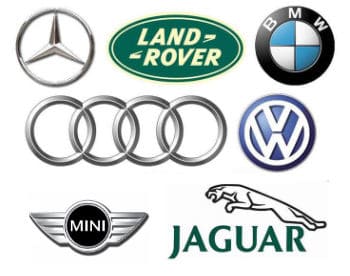
So, you are considering purchasing that beautiful, luxury European vehicle, maybe a BMW, Mercedes Benz, Audi, or VW – are you prepared for the associated costs of ownership, including maintenance and repair? Owning a European vehicle will be more expensive to own than an American or Asian car or truck. What makes them more expensive (and is it worth it?)?
First, consider these costs of ownership when deciding whether to purchase a European vs. an American- or Asian-produced vehicle:
- Purchase Price (plus interest costs, if financing)
- Taxes and Licensing Fees
- Insurance Premiums
- Gas
- Maintenance
- Repairs
- Depreciation (per CARFAX Nov. 2018, the value of a new car drops 20% after the first 12 months, and approximately 10% per year annually for the next 4 years)
First, the cost of engineering, technology, manufacturing, and shipping will contribute to the initial purchase price of a European vehicle, which can be substantial. Although some European cars are built in the United States, most are still actually produced in Europe. The exchange rates, labor costs, and tariffs, which can be variable and unpredictable, are built into the price of the vehicle. Advanced engineering is what makes these vehicles fun to drive, as well as feeling very sturdy and solid. High-end interior and exterior finishes also contribute to that luxury feel and add to the price. Even the brand name of the vehicle adds to the cost – you will pay simply for the name of Jaguar, Mercedes Benz, or Audi etc. on your vehicle!
Be aware of published “Costs of Maintenance” for individual makes and models of vehicles. These are an average of what routine maintenance services will cost over time, and are based upon individual Manufacturer’s Maintenance Schedules. Be aware that manufacturers may extend the recommended time between oil changes to decrease these costs of ownership, to improve sales of their cars. For example, the “normal” driving conditions maintenance schedule on some European turbo vehicles calls for oil changes every 15,000 miles (* see notes below on “severe” driving conditions). Per our European technician, because of the high heat (over 1300 degrees) that turbo engines generate, he recommends changing the oil every 5,000 miles (which is what he would do if maintaining his own car and he wanted it to last many years). Miles and temperature take a toll on engines, and the best insurance against having problems and expensive repairs is to do regular oil and fluid changes.
Given that the purchase price on luxury European cars is typically higher than our American or Asian vehicles, it follows that taxes, licensing, and insurance will also increase. Check into these prices before you buy that car you have been dreaming about. Nothing takes away from the enjoyment of owning that really nice car than the surprise of unexpectedly high costs to just get it on the road!
Be aware that most European vehicles have specific high standards called out on oil and fluids that can be used in the car. These grades of oils come with a higher price tag, as they cost the automotive shops more to purchase and typically cannot be purchased in bulk. Belts, hoses, brake pads and rotors, as well as many other parts that are considered wear items and require periodic replacement, are more expensive for each specific European vehicle when compared to a comparable American or Asian vehicle. Even aftermarket parts (not Original Equipment Manufacturer -OEM- parts) run higher than a comparable part for American/Asian vehicle.
Diagnostic software that is specific to each European manufacturer is more expensive than American/Asian software. This software accesses the “brains”, or computers in the car that will give a technician information (diagnostic codes and pin-point testing, which tell him/her where to start looking for the problem. All of these tools add to the costs of maintenance and repairs.
According to YourMechanic.com and Consumer Reports, the most expensive cars to maintain over a 10-year period are BMW, Mercedes-Benz, Volvo, Jaguar, and Audi. Land Rover comes in at #15, Volkswagon at #22, and Mini Cooper at #25. As a comparison, Lexus average costs over 10 years is $7000 vs. $17,800 for BMW. Toyota is lowest at $5,500.
Driving a luxury European model of car can be a great experience, and the superior performance and handling can make them a pleasure to drive. However, they are much more fun and enjoyable when you are prepared for the associated costs that come with that ownership. At Honest Accurate Auto Service, we have the tools, technicians, and experience to keep your European vehicle driving safely and reliably for years to come.
*All manufacturers base their cost of ownership and maintenance on “normal” driving conditions, not on “severe” driving conditions. Operating your vehicle in Colorado will place significantly higher demands on all your drivetrain components when compared to say, California. We live and operate at higher altitudes, steeper grades (mountains) and significant climactic swings (winter vs. summer temperatures (which can occur all in one day sometimes!). All of these conditions are hard on your car. To optimize the life of your vehicle, you should maintain your vehicle under the “severe” driving conditions schedule.



